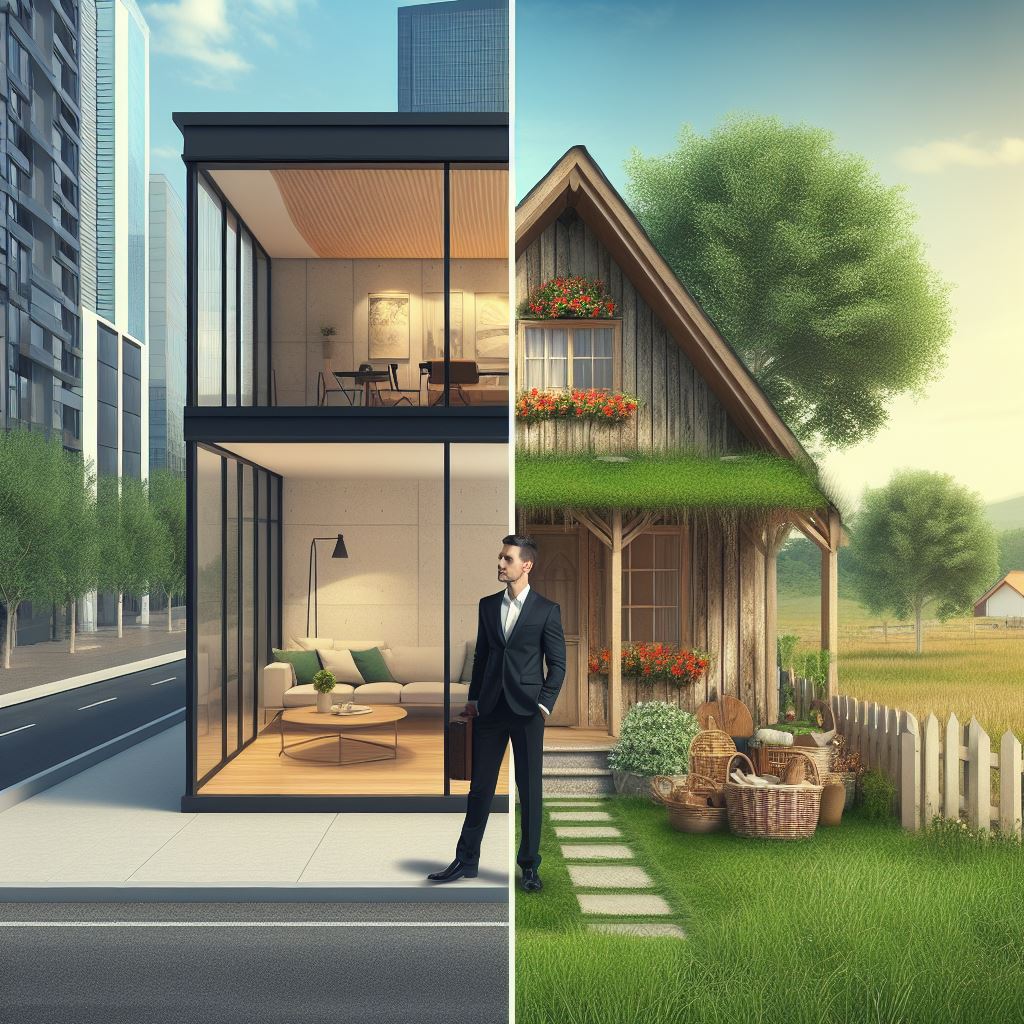Introduction
Urban and rural real estate represent two vastly different landscapes in the realm of property ownership.
Urban real estate typically refers to properties located within cities or densely populated areas, characterized by high-rise buildings, bustling streets, and proximity to various amenities such as restaurants, shops, and cultural attractions.
On the other hand, rural real estate encompasses properties situated in less densely populated areas, often surrounded by nature, farmland, or small communities.
These properties offer a quieter, more secluded lifestyle away from the hustle and bustle of urban centers.
The decision to invest in urban or rural real estate is a crucial one that can significantly impact your lifestyle, financial investment, and overall satisfaction with your property.
Choosing the right type of real estate involves careful consideration of various factors, including personal preferences, long-term goals, and practical needs.
Whether you’re looking for a vibrant urban lifestyle or seeking tranquility in the countryside, selecting the appropriate type of real estate is essential to achieving your desired lifestyle and financial objectives.
In this blog post, we will delve deeper into the urban versus rural real estate debate, exploring the distinct advantages and disadvantages of each option.
We will examine factors such as affordability, lifestyle preferences, investment potential, and quality of life considerations to help you make an informed decision.
Additionally, we will provide practical tips and considerations to guide you through the decision-making process, ensuring that you choose the type of real estate that aligns with your unique needs and preferences.
Whether you’re drawn to the excitement of city living or the tranquility of rural landscapes, this blog post aims to provide valuable insights to help you navigate the urban versus rural real estate dilemma.
Advantages of Urban Real Estate
Living in an urban area has several advantages when it comes to real estate.
Urban real estate offers easy access to a wide range of amenities and services.
Access to amenities and services
One of the main advantages is the proximity to shopping centers, restaurants, and entertainment options.
This means residents can conveniently fulfill their daily needs and enjoy recreational activities without having to travel long distances.
Urban areas also have a higher concentration of healthcare facilities and educational institutions.
This ensures that residents have access to quality medical care and a variety of educational opportunities for themselves and their families.
Better job opportunities
Another significant advantage of urban real estate is the better job opportunities it offers.
Urban areas are typically home to diverse industries, resulting in a higher demand for skilled professionals across various sectors.
This increases the chances of finding well-paying jobs and advancing one’s career.
Efficient transportation networks
Moreover, urban areas often have efficient transportation networks.
Public transportation options, such as buses, trains, and subways, are readily available, reducing the reliance on private vehicles.
This not only saves money on transportation costs but also helps reduce traffic congestion and air pollution.
Additionally, infrastructure development in urban areas contributes to shorter commuting times.
Well-connected roads, highways, and development of new transportation projects make it easier for residents to reach their workplaces, reducing travel time and stress.
In fact, urban real estate offers numerous advantages.
Access to amenities and services, including shopping centers, restaurants, and entertainment options, is conveniently available.
Healthcare facilities and educational institutions are easily accessible.
The presence of diverse industries provides better job opportunities, and efficient transportation networks make commuting easier and faster.
These advantages make urban real estate an attractive choice for individuals seeking convenience and a higher quality of life.
Read: REITs: Easy Real Estate Investment
Disadvantages of Urban Real Estate
Urban living has its advantages, such as access to amenities, cultural diversity, and better job opportunities.
However, it also comes with a set of disadvantages that one must consider before deciding on urban real estate.
Higher cost of living
One of the major drawbacks of urban real estate is the higher cost of living.
Housing prices and rental rates in urban areas are generally exorbitant, making it difficult for individuals to afford suitable accommodations.
The demand for housing in cities is often higher than the supply, leading to inflated prices.
Additionally, essential services and commodities, such as food, transportation, and healthcare, tend to be more expensive in urban areas.
Increased competition for resources
Another disadvantage of urban real estate is increased competition for resources.
Cities are known for their limited open spaces, parks, and recreational areas.
This lack of green spaces restricts the residents’ access to nature, leading to a decrease in mental and physical well-being
Furthermore, crowded public areas and increased noise pollution are common in urban settings, making it challenging for individuals to find peace and tranquility.
Safety and security concerns
Safety and security concerns are also prevalent in urban real estate.
Densely populated areas often experience higher crime rates compared to rural regions.
Cases of theft, vandalism, and assault are more common in cities, creating an environment that raises concerns about personal safety.
Moreover, the concentration of vehicles, factories, and industrial activities in urban areas increases the potential for pollution and health risks.
In short, while urban real estate offers various advantages, such as access to amenities and better job opportunities, it is essential to consider the downsides before making a decision.
The higher cost of living, including expensive housing prices and rental rates, can be a significant financial burden.
Increased competition for resources, limited access to nature, and crowded public areas also affect the quality of life in urban settings.
Lastly, safety and security concerns, alongside potential pollution levels, are drawbacks that individuals must take into account.
Ultimately, finding a balance between the advantages and disadvantages is crucial when choosing between urban and rural real estate.
Read: Investing in Land: Potential and Pitfalls

Advantages of Rural Real Estate
Rural real estate offers numerous advantages compared to urban real estate.
In this section, we will explore the benefits of choosing rural properties over their urban counterparts.
Lower cost of living
One of the most significant advantages of rural real estate is the lower cost of living.
Affordable housing options and lower property taxes make rural areas an attractive choice for those looking to save money and reduce their expenses.
Furthermore, rural areas often offer a more economical access to basic necessities.
Groceries, healthcare services, and other essential amenities tend to come with lower price tags, helping residents manage their finances more effectively.
Tranquility and natural beauty
Rural properties provide a serene environment away from the hustle and bustle of city life.
The abundance of open spaces and closer proximity to nature offer a sense of tranquility and natural beauty that is hard to find in urban areas.
In rural locations, individuals can enjoy the breathtaking landscapes, breathe in fresh air, and experience the peace that comes with being surrounded by nature.
This proximity to the outdoors also presents endless opportunities for outdoor activities like hiking, gardening, and stargazing.
Additionally, living in a rural area promotes a healthier lifestyle.
The accessibility to outdoor spaces encourages physical activities, reducing the reliance on gym memberships or organized sports.
The slower pace of life allows individuals to prioritize their wellbeing and focus on maintaining a balanced, stress-free existence.
Sense of community and slower pace of life
Rural areas have a strong sense of community and offer a closer-knit lifestyle.
In these close-knit communities, neighbors often form stronger bonds and actively engage in fostering a sense of belonging and togetherness.
The slower pace of life in rural areas is advantageous for individuals seeking a more relaxed and fulfilling existence.
Reduced stress levels contribute to improved mental well-being and can positively impact one’s overall quality of life.
In essence, the advantages of choosing rural real estate over urban real estate are numerous.
Lower cost of living, tranquility and natural beauty, and a stronger sense of community and slower pace of life are among the key benefits that individuals can enjoy in rural areas.
Ultimately, the decision between urban and rural real estate boils down to personal preferences and lifestyle priorities.
Read: Appalachia’s Real Estate Outlook for 2024
Disadvantages of Rural Real Estate
When it comes to choosing between urban and rural real estate, it’s important to consider the disadvantages of rural properties.
While there are certainly advantages to living in a rural area, such as peace and tranquility, there are also drawbacks that potential buyers should be aware of.
Limited access to amenities and services
One major disadvantage of rural real estate is the limited access to amenities and services.
Compared to urban areas, rural communities often have longer distances to shopping centers and healthcare facilities.
This can be inconvenient for residents, especially those who rely on regular access to these services.
Additionally, rural areas typically have fewer educational and employment opportunities compared to their urban counterparts, which may limit career growth and educational options for residents.
Lack of efficient transportation systems
Another drawback of rural real estate is the lack of efficient transportation systems.
Rural areas often have limited public transportation options, making residents depend on private vehicles.
This can be costly and inconvenient for those without access to a car.
Additionally, increased travel time due to longer distances and potential isolation can make it difficult for rural residents to commute to work or engage in social activities.
Challenges with infrastructure and technological advancements
Furthermore, rural areas can face challenges with infrastructure and technological advancements.
Limited access to reliable internet service and slower connection speeds can hinder residents’ ability to work remotely or access online resources.
Additionally, there may be potential difficulties in accessing utilities like electricity and water, which can impact the quality of life for rural residents.
In essence, while rural real estate can offer a peaceful and serene lifestyle, it’s important to consider the disadvantages it presents.
Limited access to amenities and services, lack of efficient transportation systems, and challenges with infrastructure and technological advancements are all factors that potential buyers should take into account.
Ultimately, the decision between urban and rural real estate depends on individual preferences and lifestyle needs.
Read: Rust Belt Revival: Emerging Markets
Factors to Consider in Making a Choice
Choosing between urban and rural real estate involves a multitude of factors that can significantly impact one’s quality of life and financial well-being.
Understanding these factors is crucial for making an informed decision that aligns with your lifestyle preferences and long-term goals.
Lifestyle preferences and personal needs
Consider your preferred lifestyle and personal needs.
Are you someone who thrives in the hustle and bustle of city life, or do you crave the tranquility and space offered by rural living? Assess factors such as proximity to amenities, entertainment options, and community atmosphere that contribute to your overall satisfaction with your living environment.
Career opportunities and work location
Evaluate the availability of career opportunities and the proximity of your potential work location to your chosen real estate.
Urban areas typically offer a wider range of job opportunities across various industries, while rural areas may have fewer options but offer a more relaxed pace of life and potentially lower cost of living.
Financial considerations and affordability
Compare the financial aspects of urban and rural real estate, including property prices, taxes, and living expenses.
While urban properties often come with a higher price tag, they may offer greater potential for rental income or property appreciation.
Rural properties, on the other hand, may provide more affordable housing options and lower ongoing expenses.
Family requirements and access to essential services
Take into account your family’s needs and access to essential services such as healthcare, education, and transportation.
Urban areas typically offer a wider range of amenities and services, including top-rated schools and advanced medical facilities.
However, rural areas may provide a closer-knit community and a safer environment for raising a family.
Future potential for growth and property value appreciation
Assess the future potential for growth and property value appreciation in both urban and rural areas.
Urban centers often experience rapid development and infrastructure improvements, driving up property values over time.
However, rural areas may offer investment opportunities in emerging markets or desirable locations for vacation homes and retreats.
Basically, the decision between urban and rural real estate depends on a combination of lifestyle preferences, financial considerations, and long-term goals.
By carefully evaluating these factors, you can make an informed choice that best suits your individual needs and circumstances.
Conclusion
In weighing the options between urban and rural real estate, it’s crucial to understand the distinct advantages and disadvantages each offers.
Urban areas promise convenience, with easy access to amenities, job opportunities, and cultural experiences.
However, they come with higher costs of living, congestion, and sometimes a lack of green spaces.
On the other hand, rural areas offer peace, tranquility, and often more affordable housing.
Yet, they may be distant from amenities and job centers, potentially leading to isolation.
The decision between urban and rural living is deeply personal and should be based on individual circumstances and preferences.
Consider factors such as career, family needs, lifestyle preferences, and long-term goals.
What works for one person may not work for another.
Take the time to evaluate your priorities and how they align with the pros and cons of each setting.
Navigating the real estate market, whether urban or rural, can be daunting.
Seeking guidance from experienced real estate professionals can provide invaluable insights and help you make informed decisions.
They can offer expertise on market trends, property values, and potential investment opportunities.
Don’t hesitate to lean on their knowledge and experience to guide you through the process.
Ultimately, finding the right balance between urban and rural living is about striking a harmony that aligns with your lifestyle and aspirations.
It’s about creating a space where you feel comfortable, connected, and fulfilled.
Whether you choose the hustle and bustle of city life or the serenity of the countryside, what matters most is that it meets your needs and enhances your overall quality of life.
Remember, there’s no one-size-fits-all answer.
Embrace the journey of exploration and discovery as you find your place in the world of real estate.




